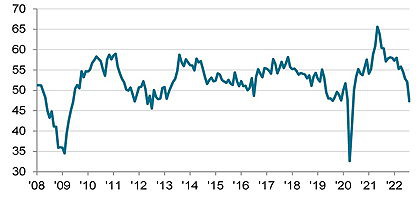UK manufacturing drop is steepest since first Covid lockdown

UK manufacturing production suffered its steepest decline in August since May 2020. Companies experienced a sharp reversal in new orders, with demand from domestic and overseas clients contracting sharply. This led to a near stalling of jobs growth and drop in business optimism, according to the latest Purchasing Managers’ Index (PMI) for UK manufacturing produced by S&P Global and the Chartered Institute of Procurement & Supply (CIPS).
The seasonally adjusted PMI fell to 47.3 in August, down from 52.1 in July. This is the first sub-50 PMI – representing contraction – since May 2020.
Manufacturing production registered a steep decrease during August, reflecting weaker intakes of new work, reduced new export business and shortages of both staff and raw materials.
August saw intakes of new work fall at the quickest pace for 27 months. There were also reports of customers postponing, rescheduling or cancelling agreements in light of rising economic uncertainties, recession warnings and component shortages.
Foreign demand suffered its steepest fall since May 2020, with order intakes from markets such as the US, the EU and China all decreasing. Port congestion, supply chain issues, Brexit complications and inflationary pressures also contributed to the latest contraction in new export business.
Jobs growth ground to a near-standstill – its weakest performance in a 20-month-long sequence of increases. Cuts at small- and large-scale producers offset a “solid” increase at medium-sized manufacturers. There were reports of recruitment difficulties (such as skill shortages and a competitive hiring market), employees leaving for better paying jobs, and capacity being cut in line with reduced new order intakes.
Levels of work-in-hand and purchasing activity were both reduced to the greatest extents since mid-2020. Lower new order intakes enabled firms to catch-up on backlogs.
August also saw business optimism slump to a 28-month low, amid rising concerns about a possible UK recession, strong inflationary pressure and the potential impact of the cost of living crisis on consumer demand.
However, 46% of UK manufacturers still expect output to rise over the coming year, reflecting hopes for reduced input shortages, planned investment spending, new product launches, a revival in export sales and proactive marketing strategies.
“August saw the UK manufacturing sector suffer its steepest downturn since the first Covid-19 lockdown,” reports S&P Global Market Intelligence director, Rob Dobson. “Output and new orders contracted at the fastest rates since May 2020, as inflows of work from both domestic and export markets slumped sharply lower.
“The deepening downturn also impacted trends in employment, purchasing and business optimism,” he adds. “The rate of job creation came to a near-standstill, while input buying was cut back sharply – hitting demand at suppliers. Business optimism sank to a 28-month low as companies noted that the horizon was darkening amid concerns about recession and the impact of the cost of living crisis.

"There was better news on prices, however,” says Dobson. “Although still elevated, rates of input cost and selling price inflation both eased sharply, which could take some considerable pressure off consumer price inflation in the coming months, albeit with energy prices remaining a key concern and area of great uncertainty as we head into the autumn.”
“The inflationary clouds that have been building over the UK manufacturing industry have finally burst, with a dramatic fall in demand creating the sharpest reduction of new orders since May 2020,” adds CIPS chief economist, John Glen. “But there is a glimmer of hope that increasingly robust global supply chains could be key to halting rising prices.
“There is no escape from plummeting new orders for UK manufacturers,” Glen continues. “Clients at home and abroad in the US, EU and China are looking to cut their costs, with reports of cancelled and postponed contracts this month. Disruption at the UK’s busiest container port in August has certainly not helped exporters.
However, he finds some cause for optimism. “While the Ukraine crisis, container and component shortages are still holding back UK manufacturers, there are signs that the worst supply chain disruption is now behind us,” he says. “Raw material price increases are finally starting to slow, backlogs of work are declining, and prices on store shelves are starting to stabilise. UK manufacturers will be hoping that supply chain disruption eases long enough to drive down costs for good.”
According to Make UK senior economist James Brougham, “this morning’s PMI figure, indicating recessionary performance in the manufacturing sector, is the worst in 2¼ years. Industry is finding maintaining output levels a significant challenge, especially when average input prices are a whopping 22.6% higher now than they were at the same time last year. One enduring pillar of hope for UK manufacturing – high demand for its goods in recent times – has fallen now too, as both domestic and foreign customers batten down the hatches for what is shaping up to be a winter of discontent.
“Even with this decline in demand, inflationary pressures persist regardless, fuelling the ever-increasing likelihood of stagflation in the UK economy,” Brougham continued. “This morning’s data is a significant – and perhaps the last – warning shot for Government. Immediate intervention is necessary to mitigate the worst of the economic damage to the industry’s fabric. Many of our European peers have already moved to such action, something the UK government should look to mimic if the UK manufacturing base is to keep its head above water.”
• Much of the Eurozone is also reporting weak PMI figures with Germany (on 59.1) and Italy (on 48.0) both recording 26-month lows, and Ireland (51.1) hitting a 22-month low. By contrast, France (50.6) and Spain (49.9) both recorded two-month highs. Across the Eurozone as a whole, the PMI fell to 49.6 – another 26-month low, although manufacturing output rose slightly to 46.5 – its highest for two months.
IHS Markit: Twitter LinkedIn Facebook
SPS Global: Twitter LinkedIn Facebook





